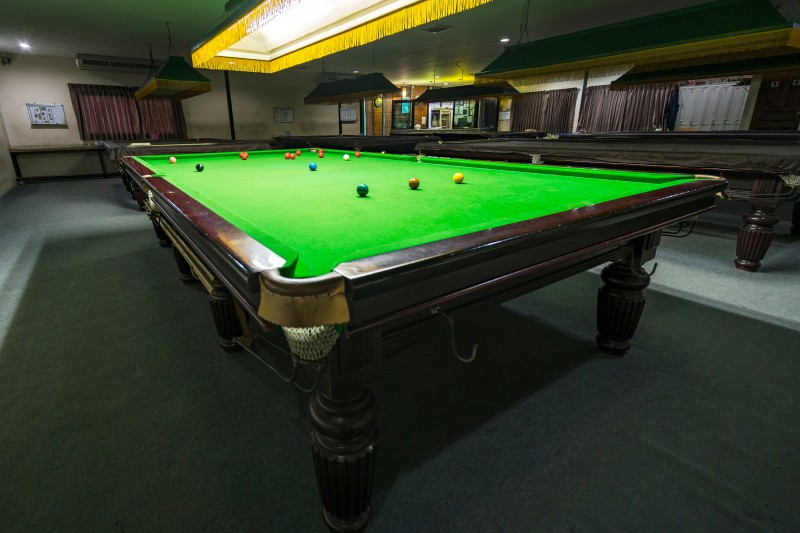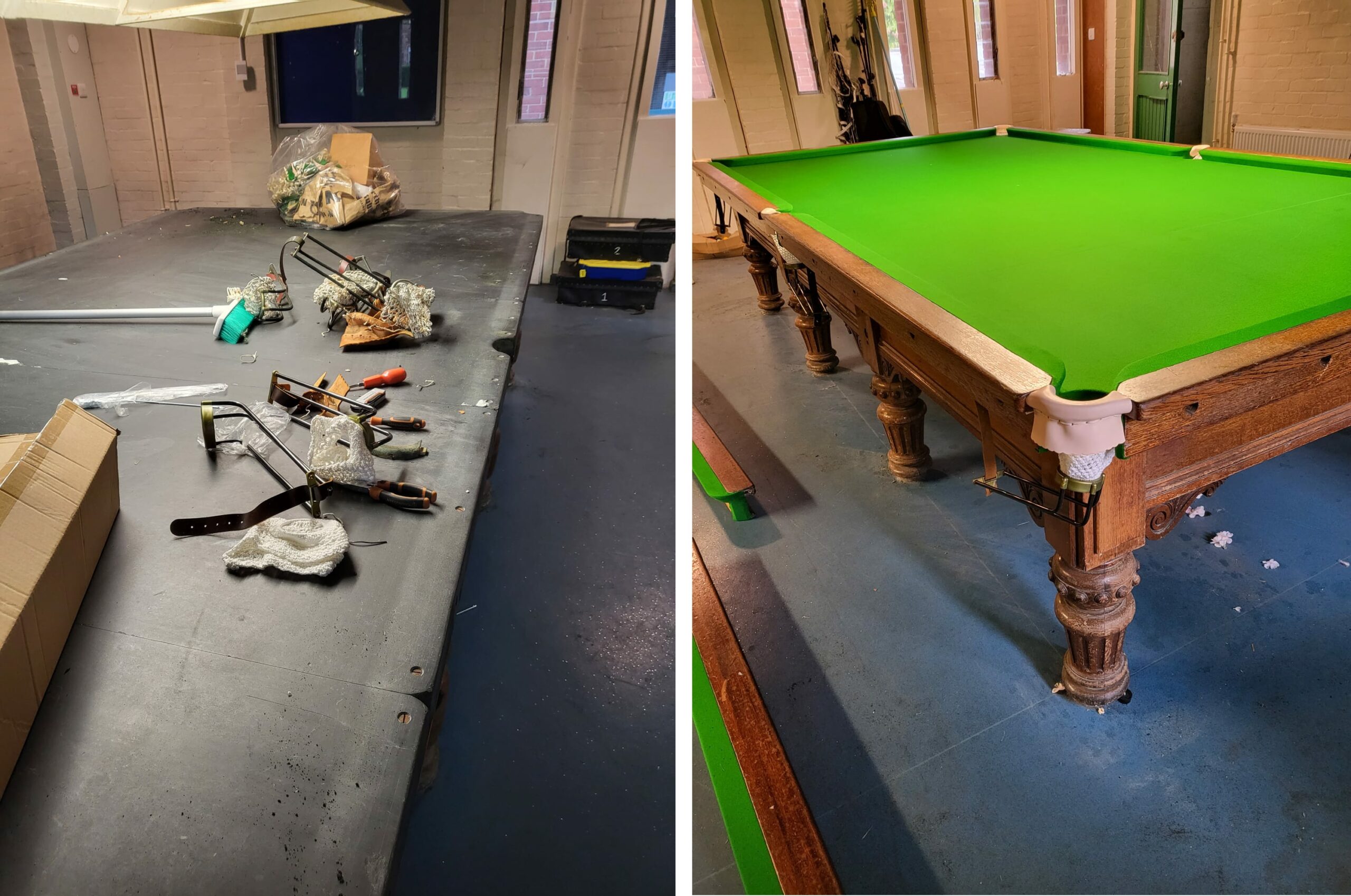The Elegance of Slate Bed Snooker Tables
The snooker table has a storied history in the UK. Its transformation over the years has seen numerous changes in materials and craftsmanship. Yet, one element remains quintessential: the slate bed snooker table.
Brief history of snooker tables in the UK
In the heart of the UK, snooker emerged as a favourite pastime, dating back to the 19th century. The game evolved, and so did its core equipment. Initially:
- Tables made of wooden beds were common.
- Manufacturers then adopted slate for its impeccable flatness.
The shift to slate was revolutionary. Its impact was profound, resulting in a dramatic enhancement in the game’s precision and playability.
The significance of slate in the game’s evolution
You might wonder, why did slate gain such prominence? The answer lies in the material’s unique attributes:
- Stability: Unlike wood, slate doesn’t warp or change shape over time. This ensures a consistently flat playing surface.
- Durability: A slate bed snooker table is built to last. It stands resilient against wear and tear, serving players for generations.
- Precision: With its unrivalled flatness, slate offers an unparalleled level of gameplay precision. It’s the choice of professionals and enthusiasts alike.
But it’s not just about functionality. The aesthetics of a slate bed table are unmatched. With its sleek, polished look, a slate bed snooker table becomes the centrepiece of any room or club. It’s a testament to the blend of form and function – a harmonious union of beauty and utility.
In essence, the evolution of the snooker table in the UK is deeply intertwined with slate. It’s a relationship built on trust, quality, and a shared commitment to elevating the game. As a snooker table specialist, I can attest to the magic of slate. It’s transformed snooker, propelling it to new heights of precision and grandeur.
In the world of snooker, the slate bed snooker table stands as an icon. It’s more than just a piece of equipment; it’s a symbol of the game’s rich history, its evolution, and its enduring charm.
Why Slate? Understanding the Superiority of a Slate Bed

When you’re deeply involved in the snooker community, as I am, one question frequently pops up: Why do professionals and aficionados consistently gravitate towards a slate bed snooker table? Let’s dive deep into the undeniable allure of slate and its pivotal role in refining the game of snooker.
The unique properties of slate
Slate, a fine-grained, metamorphic rock, has carved its niche in the snooker world due to some inherent attributes:
- Non-porous Nature: Slate resists moisture, ensuring that damp environments don’t ruin your gameplay.
- Uniformity: Each slate piece offers a consistent playing surface, free from unexpected bumps or dips.
This inherent uniformity and resistance to moisture make slate the cornerstone of professional snooker. When you play on a slate bed table, you experience a difference – a smooth roll, predictable bounces, and unparalleled accuracy.
How slate impacts the accuracy and precision of gameplay
There’s no denying that the material beneath the green felt plays a monumental role in determining the game’s outcome. Let’s consider the aspects that make slate indispensable:
- Consistency: The table remains unaffected by temperature fluctuations, ensuring an even playing field at all times.
- Response: Balls react more predictably on slate, owing to its flawless surface.
The superior accuracy and precision offered by slate bed snooker tables can be a game-changer. For clubs aiming to provide their members with the best, or for enthusiasts wanting to hone their skills, slate becomes the obvious choice.
Comparison with other materials like wood or MDF
While alternative materials such as wood or MDF might come with a reduced price tag, they come with their share of challenges:
- Warpage: Wooden or MDF tables can warp over time, affecting gameplay.
- Lifespan: These materials tend to wear out faster than slate, demanding more frequent replacements.
Investing in a slate bed snooker table, on the other hand, is an investment in quality, precision, and longevity. There’s a reason professionals and snooker clubs across the UK prefer slate – it’s simply the best. The tactile feel, the reliability, and the unmatched gameplay experience it provides are incomparable.
In the grand tapestry of snooker, the significance of slate cannot be overstated. It’s the bedrock on which champions are made and where memories are forged. A slate bed snooker table isn’t just a purchase; it’s an investment in excellence.
Caring for Your Slate Bed Snooker Table: Maintenance Tips and Tricks

Being a snooker table specialist, I’ve seen the radiant beauty of a well-maintained slate bed snooker table and the decline of one that’s been neglected. As a proud owner or a club manager, understanding the proper care for your table ensures it not only looks pristine but also delivers optimal performance for years to come.
Daily and monthly maintenance routines
Consistent care is the cornerstone of a table’s longevity. Here’s a recommended maintenance routine:
- Daily: Gently brush the table surface to remove chalk residue and dust. Always brush in one direction, from the baulk end to the opposite end.
- Monthly: Vacuum the table using a soft nozzle attachment to get rid of accumulated dust. Additionally, check for any signs of wear or damage, especially around pocket areas.
These routine checks and cleans safeguard the table’s integrity, ensuring it remains in tip-top condition.
Addressing common problems: chipping, unevenness, and temperature effects
Despite our best efforts, occasional issues can arise. Let’s tackle a few:
- Chipping: Slate, though durable, can chip. If you notice any chips, contact a professional. A quick fix can prevent further damage.
- Unevenness: Over time, the table might become uneven. Regularly inspect by rolling a ball. If it veers off, it might be time for a re-leveling session.
- Temperature Effects: Extreme temperatures can affect the cloth’s stretch. Keep your slate bed snooker table away from direct sunlight and ensure a stable room temperature.
Being proactive about these issues will ensure your table remains a beloved centerpiece for gameplay.
Expert insights: when to seek professional help
There’s a line between general maintenance and situations demanding expert intervention. Here are a few pointers:
- Relocation: Moving your table? Always hire professionals. They’ll ensure the slate bed remains intact during the move.
- Resurfacing: Over time, the cloth might wear out. For a cloth replacement, always trust a seasoned expert for a flawless job.
There’s a certain art to caring for a slate bed snooker table. These majestic creations, with their hefty weight and intricate design, are both durable and delicate. With the right care, they become a legacy, passed down through generations, each game echoing with the laughter and challenges of the past.
In the realm of snooker, where precision and beauty merge, ensuring the pinnacle of table health is paramount. It’s not just about aesthetics; it’s about honouring the game and the cherished moments woven into every match.
Investing Wisely: Factors to Consider When Buying a Slate Bed Snooker Table
Delving into the realm of snooker, especially as a prospective owner, brings forth a plethora of choices. As a seasoned snooker table specialist, I’ve provided countless consultations, and one thing is clear: purchasing a slate bed snooker table is an investment of both money and passion. To ensure you make an informed decision, it’s essential to scrutinise various factors that contribute to the table’s quality, longevity, and overall value.
Understanding the slate thickness
The heart of any snooker table is its slate bed, and thickness plays a pivotal role:
- Standard Thickness: Most professional tables boast a thickness of around 1-1.5 inches, providing optimal playing conditions.
- Varied Thickness: Some tables might offer varying thickness levels. While thinner slates are lightweight, they may compromise on the quality of gameplay.
- Joint Quality: Ensure the slate sections join seamlessly. Any discrepancies can severely affect ball movement.
The slate’s thickness directly impacts the table’s performance, so it’s crucial to choose wisely.
Frame and build quality
A sturdy frame is the backbone of a slate bed snooker table. When assessing the table:
- Material: Opt for hardwoods like mahogany or oak, renowned for their durability and longevity.
- Construction: Look for frames with reinforced corners and robust leg designs to support the weight of the slate.
- Finish: The finish not only enhances aesthetics but also offers protection against scratches, spills, and environmental factors.
- Levelers: Ensure the table comes with adjustable leg levelers to maintain a perfectly flat playing surface irrespective of the floor’s condition.
A table’s frame determines its life span, so don’t cut corners on quality.
Additional features and accessories
Beyond the table itself, accessories and added features can elevate your snooker experience:
- Cloth Quality: Invest in high-quality cloth like woolen or worsted varieties to ensure smooth gameplay and reduced wear.
- Pocket Design: Pockets should be well-fitted, neither too tight nor too loose, ensuring a fair challenge.
- Added Features: Some tables come with built-in storage for cues and balls, offering convenience and a cleaner look.
While the table is the star, accessories and features enhance the overall experience, so consider them integral to your investment.
To wrap it up, buying a slate bed snooker table is a commitment. It’s a blend of art, craftsmanship, and engineering. By factoring in the slate’s thickness, frame quality, and additional features, you’re not just purchasing a table—you’re investing in countless moments of joy, challenges, and memories that will last a lifetime.
For further advice on the best Slate Bed Snooker Tables contact me at IQ Pool Tables or call 0161 494 8485
